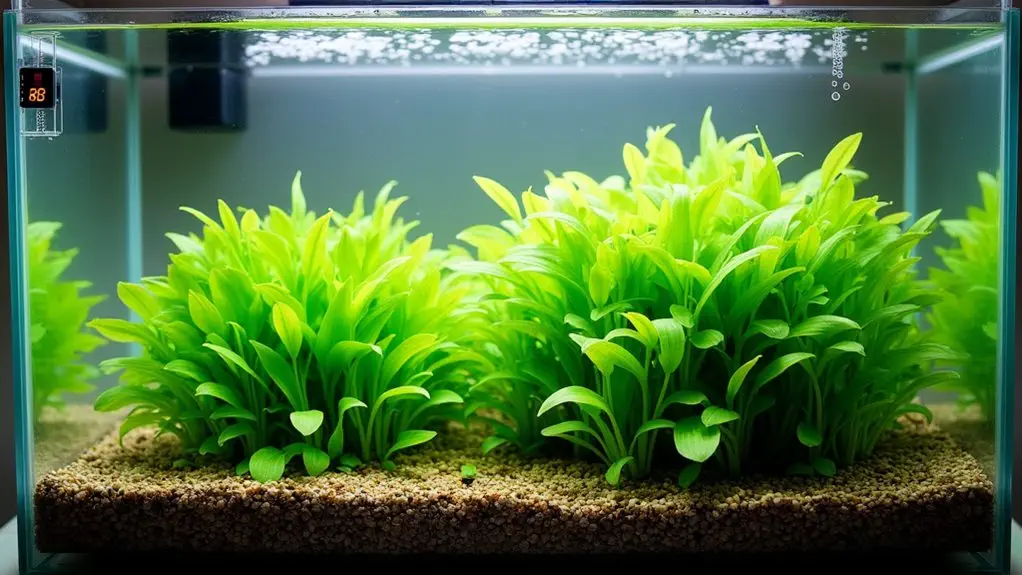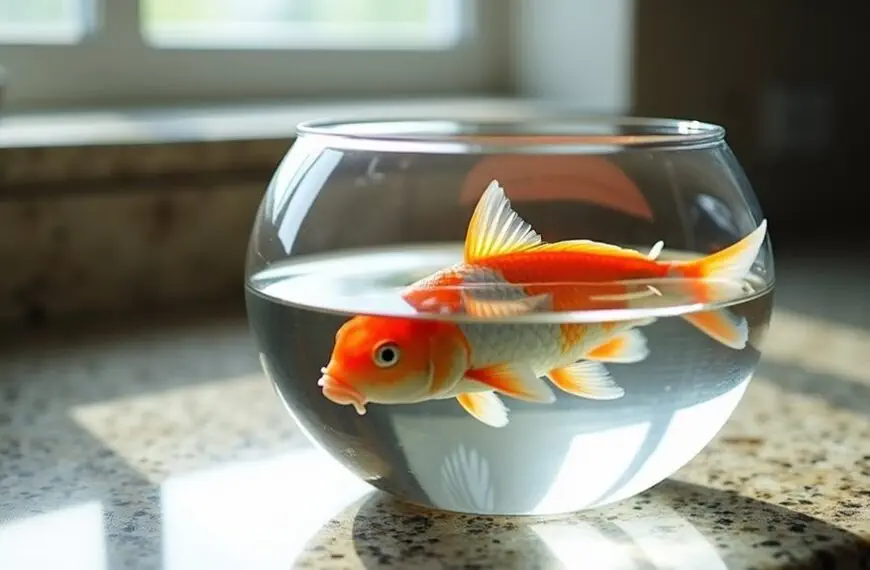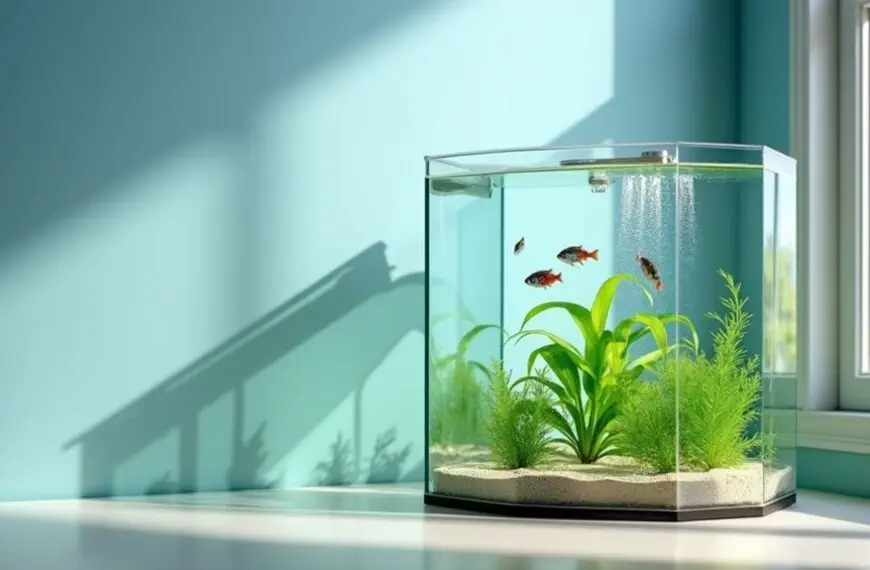Your tank is ready for fish when several key conditions are met. You'll want to see stable water parameters with zero ammonia and nitrites, while having manageable nitrate levels – this means your nitrogen cycle is complete. Your pH should stay steady between 6.8-7.8 for freshwater tanks, and temperature should hold constant between 75-80°F. Test your water regularly with a liquid test kit (they're more accurate than strips), and verify your filter is running smoothly with proper flow rate. Don't forget to check that all equipment is working properly and you've got enough space for your chosen fish. There's more to evaluate, but these basics will get you swimming in the right direction.
Contents
Water Parameters and Testing Results
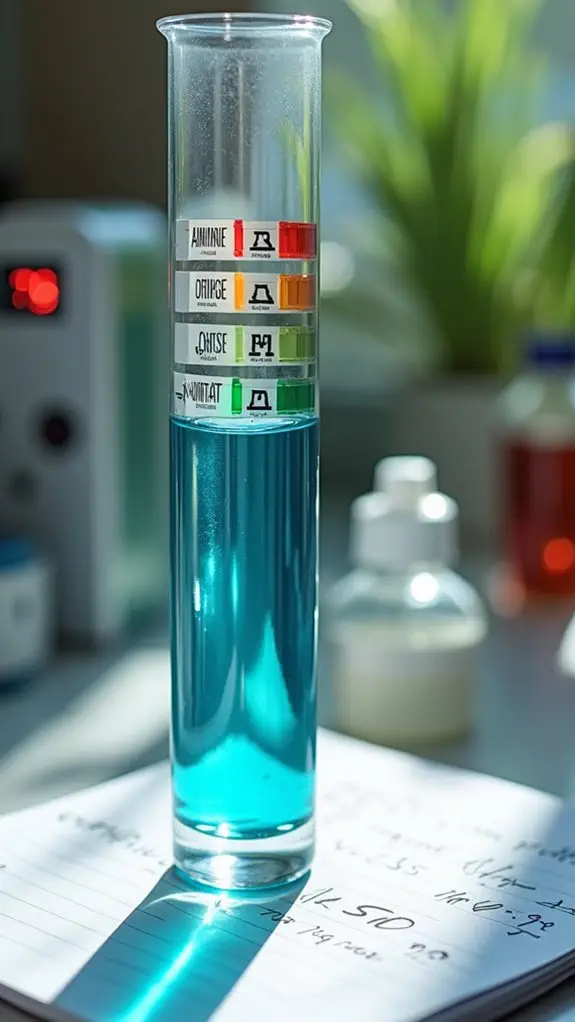
The proper water parameters are vital for maintaining a healthy aquarium environment. Before adding any fish to your tank, you'll need to verify your water conditions meet specific requirements through regular water testing.
For freshwater tropical tanks, you're looking for a pH between 6.5 and 7.5, while saltwater tanks need a higher pH of 8.1 to 8.4. Additional tests for calcium and phosphate are often necessary for reef tank setups, which can influence the growth of beneficial bacteria in the tank.
Temperature ranges are just as important – you'll want to maintain 72-82°F for freshwater and 76-82°F for reef tanks. Stable temperatures are critical for preventing stress in your fish.
Don't forget that ammonia should always read zero, regardless of tank type! When it comes to parameter adjustments, you'll need to monitor these levels closely using reliable test kits.
While test strips are convenient, liquid test kits typically give you more accurate readings.
Remember to test your water at least monthly, but you should increase testing frequency when introducing new fish or if your aquatic friends seem under the weather.
It's like being a water detective – you're looking for clues about your tank's health! Compare your results with the recommended levels for your specific setup, and make adjustments accordingly to create the perfect underwater home.
Nitrogen Cycle Completion Status
Understanding your tank's nitrogen cycle completion status is essential before adding fish to your aquarium. The cycle indicators you'll want to watch include ammonia, nitrite, and nitrate levels, which tell you how well your beneficial bacteria are doing their jobs.
When your tank is fully cycled, you'll see zero ammonia and nitrite readings, while nitrates will be present but manageable through regular water changes. A pH drop often occurs during cycling, so monitoring pH levels is important too. The optimal cycling environment requires temperatures between 83-87°F for the most efficient bacterial growth. Additionally, maintaining a stable temperature is crucial for fostering beneficial bacteria.
The bacteria roles in this process are fascinating – think of them as your tank's tiny cleaning crew! Nitrosomonas bacteria handle the first conversion of toxic ammonia, while Nitrobacter bacteria take care of the nitrites. You'll know they're working when your test results show the right patterns.
- Your heart will skip a beat when you see that first "zero" ammonia reading – it's like watching your garden's first sprout emerge!
- You'll feel a surge of pride when nitrites drop to zero – your bacterial team is crushing it!
- That moment when you detect nitrates is pure joy – you're almost ready for your aquatic friends!
Keep testing every couple of days until you've maintained stable readings for at least a week. Then you can confidently welcome fish to their new home!
Tank Size and Space Requirements
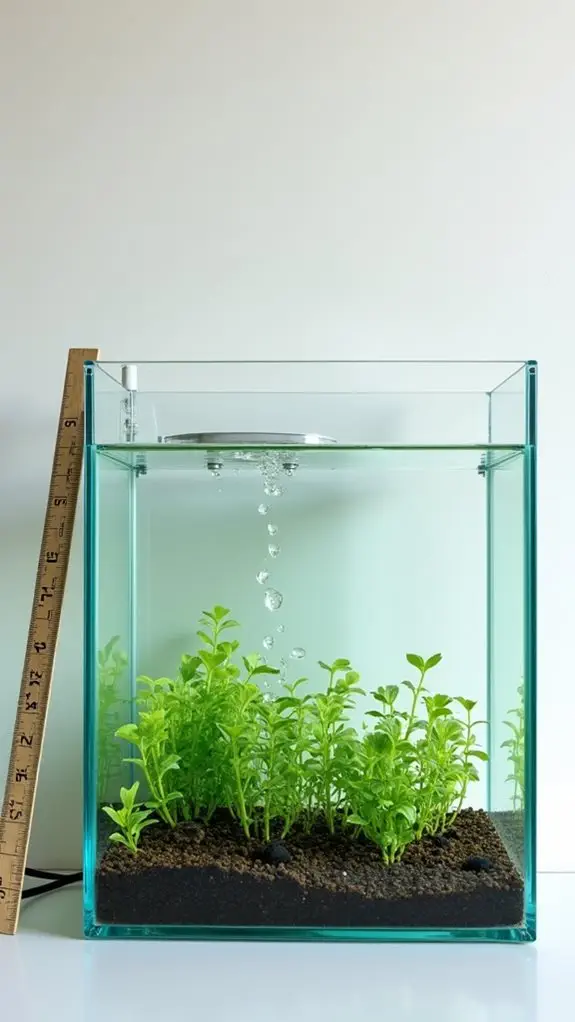
You'll need to figure out how many fish your tank can safely hold by using both the old "inch-per-gallon" rule and considering each species' unique space requirements. For example, while you might fit several small tetras in a 10-gallon tank, you'd only want one or two angelfish in a 20-gallon setup because of their size and swimming patterns. Remember that active fish species need significantly more swimming space than sedentary ones. A properly sized tank reduces anxiety levels in fish and helps them thrive. Additionally, maintaining water quality is vital, as smaller tanks can quickly accumulate toxins with higher fish density.
Calculate Fish Capacity Limits
Calculating your tank's fish capacity requires more than just following the old "inch per gallon" rule. Instead, you'll want to focus on surface area and fish species compatibility when determining how many aquatic friends can comfortably live in your tank.
Remember, different fish have unique space requirements, and tank dimension considerations play a significant role in creating a healthy environment. Most fish reach 66-75% of wild size when kept in aquariums long-term. Using a gravel cleaner tool will help maintain optimal tank conditions during regular maintenance. Additionally, maintaining appropriate water quality parameters is crucial for the health of your fish.
To determine your tank's true capacity, start by calculating the total volume (length x width x depth), then subtract 10% for decorations and equipment.
Next, consider these three essential factors that'll help you make smart stocking decisions:
- Your fish's maximum adult size – they'll grow bigger than you think, and you don't want them feeling like sardines in a can!
- The swimming patterns of your chosen species – active swimmers need more room to zoom around.
- The body shape of your fish – fuller-bodied fish need more space than slender ones.
For the most accurate results, divide your tank's length plus width by your fish's maximum size. If the result is greater than 4, you're good to go.
Keep in mind that cold water and marine tanks need extra space per fish compared to tropical setups.
Space Per Fish Species
Every fish species has distinct space requirements that directly impact their health and behavior in an aquarium. When you're planning your tank's inhabitants, you'll need to take into account both fish compatibility and tank dimensions to create a harmonious environment. Modern filtration systems can help maintain water quality even with higher fish populations. The right tank size allows for proper maintenance access to keep your aquarium clean and healthy.
For beginners, it's helpful to know that smaller fish like Bettas need at least 5 gallons, while community favorites such as Guppies and Tetras require a minimum of 10 gallons. If you're dreaming of keeping majestic Angelfish, you'll want to provide at least 20 gallons with extra vertical space – they're not called Angelfish because they stay small! It's crucial to understand that water quality management plays a key role in your tank's suitability for fish.
Remember that tank size isn't just about length – surface area plays a vital role in oxygen exchange. You'll want to follow the six times rule: your tank should be at least six times the length of your adult fish's size, and twice their length in width and depth.
And if you're planning to keep schooling fish like Neon Tetras (who love to play follow-the-leader), you'll need enough space for their natural shoaling behavior. Think of it like giving your fish their own underwater playground – they need room to zoom!
Filter System Performance
Three key elements determine a filter's effectiveness in maintaining a healthy aquarium: ammonia oxidation, media quality, and flow rate.
Your filter's ability to convert harmful ammonia into less toxic substances depends largely on the filter media you're using and how efficiently it processes waste. High-performance options like K1 media and 30 ppi foam provide excellent filtration efficiency, while standard cartridge filters might leave you wanting more.
- Your fish will thank you for investing in quality filtration – it's like giving them a luxury apartment with exceptional air purification!
- Don't let poor filtration stress you or your aquatic friends – upgrading your filter media is an easy fix.
- Getting your filter flow rate right (about 6x tank volume) is like finding that perfect water pressure in your shower.
To maximize your filter's performance, consider using a canister filter with high-quality media like Poret foam or static K1. Moreover, ensuring beneficial bacteria thrive in your filter media will contribute to the overall nitrogen cycle and keep ammonia levels low.
If you're working with a hang-on-back filter, you can boost its effectiveness by adding foam blocks and pre-filters.
Temperature and Ph Stability
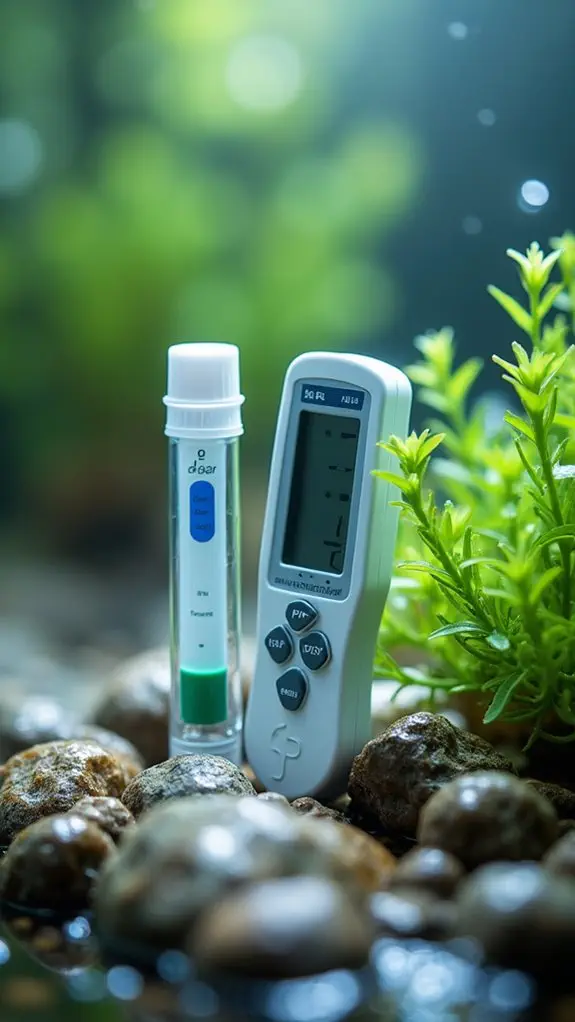
Maintaining stable temperature and pH levels marks a critical checkpoint in preparing your tank for fish. You'll need to guarantee your tank's environment stays consistent, as sudden changes can stress or even harm your future aquatic friends. Regular temperature monitoring using a reliable thermometer will help you catch any fluctuations before they become problematic.
For most tropical fish, you'll want to keep the temperature between 75-80°F, but remember that different species have specific needs. Position your heater near water flow for even distribution, and don't place your tank near windows or heating vents where temperatures can swing unexpectedly.
When making pH adjustments, take it slow – small changes are always better than dramatic ones. Most freshwater fish thrive in a pH range of 6.8 to 7.8, and you'll want to maintain these levels through regular water changes and proper aeration. Regular pH testing is vital in preventing stress and ensuring fish vitality.
Think of pH stability like maintaining the perfect bath temperature – nobody likes sudden hot or cold spots! Use a foam fractionator or refugium to help keep those levels steady, and you'll be well on your way to creating a comfortable home for your fish.
Equipment Functionality Check
Before introducing fish to your aquarium, checking all equipment functionality stands as an important step in tank preparation. You'll need to verify your pump efficiency is ideal and that all systems are running smoothly. Daily checks of pumps, heaters, and lights aren't just routine tasks – they're your tank's lifeline to success.
Filter maintenance plays a vital role in keeping your aquatic environment healthy. You'll want to clean or replace filter media regularly and monitor your system for any unusual sounds or vibrations that might signal problems.
Don't forget to inspect electrical connections and check for leaks – these small details can make a big difference in your tank's stability.
- Your fish's lives literally depend on properly functioning equipment – it's their life support system!
- A well-maintained tank brings the joy of watching happy, healthy fish thrive in their new home.
- There's nothing worse than equipment failure after adding fish – prevention is always better than cure.
Remember to test your water parameters regularly using reliable test kits, and keep detailed records of your readings. Proper monitoring of ammonia and nitrite levels is essential to ensure a safe environment for your fish.
When all your equipment checks out and maintains consistent operation, you're one step closer to welcoming those finned friends to their new home.
Aquarium Environment and Layout
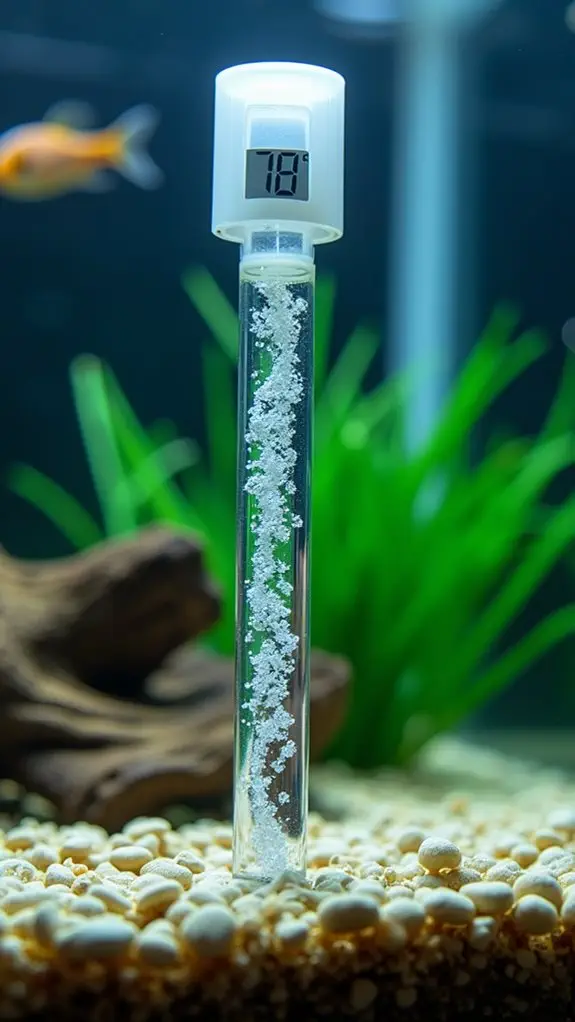
With your equipment running smoothly, it's time to focus on creating the perfect home for your future fish. Aquarium placement plays a vital role in your tank's success, so you'll want to find a spot away from direct sunlight and temperature fluctuations.
Make sure you're close to electrical outlets and water sources – trust me, you don't want to haul buckets across your entire house during water changes!
Now, let's talk about decoration balance, which is like arranging furniture in your living room, but underwater! Start by creating layers: imagine your tank as a theater stage with a foreground, midground, and background.
Choose a striking centerpiece, like an eye-catching piece of driftwood or a beautiful rock formation, and build around it. You'll want to slope your substrate slightly upward toward the back, creating depth that'll make your tank look bigger than it actually is. Keep in mind that adding live plants can greatly enhance water quality and provide essential oxygen for fish.
Remember to leave open swimming spaces – your fish aren't going to appreciate a tank that's as crowded as a rush-hour subway!
Arrange shorter plants in front and taller ones in back, creating natural-looking pathways that'll make your fish feel right at home.
Frequently Asked Questions
How Long Should I Run My Lights Before Adding Fish?
You don't need to run lights before adding fish. Once your tank is cycled, maintain a consistent light duration of 8-10 hours daily for plant growth, then gradually introduce fish for proper acclimation.
Can I Use Tap Water Directly for Water Changes?
No, you can't use tap water directly. You'll need to treat it with a dechlorinator to remove harmful chlorine and guarantee proper water quality. Let it sit for 24 hours before adding to your aquarium.
Should I Quarantine New Plants Before Adding Them to My Tank?
Yes, you should always quarantine new plants. It's essential for preventing plant pests and diseases from entering your main tank. The quarantine benefits include protecting your fish and maintaining a healthy aquarium ecosystem.
How Many Hiding Spots Should I Provide per Fish?
You'll want at least one dedicated hiding spot per fish, but add more for shy fish species. Distribute spots across different tank levels and make certain they're large enough for comfortable entry and exit.
When Is the Best Time of Day to Introduce New Fish?
You can introduce fish any time, but avoid feeding hours. While morning introductions work well, evening acclimation can be ideal since you'll naturally turn off lights afterward, helping reduce stress for new fish.
Final Thoughts
You'll know your tank is ready for fish when it's passed all the essential checks – stable water parameters, a completed nitrogen cycle, and properly functioning equipment. Don't rush this process; your fish's health depends on it. With consistent temperature, appropriate pH levels, and a well-maintained environment, you're good to go. Remember, patience in setting up your aquarium will reward you with happy, healthy fish that'll bring you joy for years to come.

